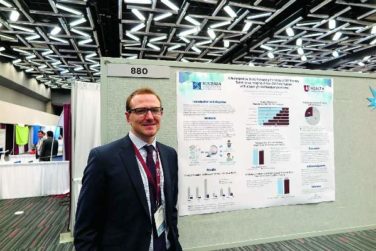EXPERT ANALYSIS FROM LASER 2015
KISSIMMEE, FLA. (FRONTLINE MEDICAL NEWS) – Ablative laser resurfacing may be the most effective cosmetic treatment for the periorbital area, excluding blepharoplasty, according to Dr. Suzanne L. Kilmer, a dermatologist specializing in laser and skin surgery in Sacramento, Calif.
“It gives you definite tightening and has the most predictable results,” Dr. Kilmer said at the annual meeting of the American Society for Laser Medicine and Surgery. “It also has the worst down time and side effects, but not for the upper lid – I’ve never had any scarring on the upper eyelid.”
In addition to its cosmetic potential, ablative laser resurfacing can remove epidermal lesions that might otherwise become actinic keratoses or basal cell carcinomas, and can smooth out syringomas, nevi, and seborrheic keratoses, Dr. Kilmer said. She shared some of her top tips for successful use of this technique.
Technique, safety, and analgesia
When treating patients with perioperative ablative laser resurfacing, Dr. Kilmer said she performs the first pass with a carbon dioxide laser at computerized pattern-generator (CPG) settings of pattern 3, size 9, density 6. She follows that with erbium laser resurfacing at a depth of 75-100 microns. “The first pass removes the epidermis,” she said. “Be sure to feather peripherally, and wipe everywhere you will do a second pass.”
The skin usually tightens visibly with the second pass, which can include the upper eyelids if patients have lax skin in this area, Dr. Kilmer noted. “You can be aggressive, like 3-9-5 [CPG settings],” she added. She then performs a “very light” second pass to the lower lids, with lower CPG settings of 3-7-3 or 3-6-2. She again follows with erbium ablation, including to the areas of the central face and midcheek.
The third pass includes the glabella and perioral area, as well as the upper eyelids if they are especially lax, Dr. Kilmer said. She ends with a sculpting pass with erbium laser.
Dr. Kilmer explained that she always treats the upper eyelids with ablative laser therapy in combination with fractional carbon dioxide laser treatment. “I also will include any area I think looks safe to do ablative on an individual patient,” she added. She noted that she sometimes combines ablative and fractional therapies with botulinum toxin treatment.
Patients should always wear eye shields during laser treatment sessions, Dr. Kilmer emphasized. Acceptable options include David-Baker lid clamps, Jaeger lid plates, and individual steel eye shields, but plastic corneal protectors should be avoided because they can sustain thermal damage with laser exposure, she said.
Options for analgesia during treatment include codeine, hydrocodone, hydromorphone, or nonsteroidal anti-inflammatory agents such as Toradol (ketorolac), which Dr. Kilmer gives intramuscularly at a dose of 30-60 mg. Furthermore, EMLA (lidocaine/prilocaine) cream enhances comfort, even if patients are also receiving conscious sedation or blocks, she said. The cream helps prevent several adverse effects, including superficial coagulative thermal damage, prolonged erythema, and delayed hypopigmentation, and does not seem to decrease efficacy, she added.
Before treatment
Clinicians should consider how a patient’s unique characteristics might affect treatment outcomes, Dr. Kilmer said. For example, ablation is more likely to cause hypopigmentation in patients with lighter skin types, and is unlikely to sufficiently resolve wrinkles that involve the facial muscles. “Always discuss Botox [botulinum toxin],” added Dr Kilmer. “If you’re tightening up the skin, and the area underneath is moving a lot, you’re not going to get as much tightening.” Clinicians also should discuss a face lift as an option for patients with substantial excess facial skin, she said.
The overall treatment plan should address existing skin lesions, too. Larger syringomas, trichoepitheliomas, and hyperplastic sebaceous glands should be “drilled out” with erbium ablation, but small tumors usually need only multiple or fractional laser treatment, said Dr. Kilmer.
For antimicrobial prophylaxis, patients should receive acyclovir, valcyclovir, or famvir starting 1 day before the procedure and continuing for 10-14 days, Dr. Kilmer said. “If I’m just treating around the eyes, I don’t worry as much about antivirals. I think about them more if I’m doing the full face,” she noted. Likewise, preoperative antibiotics such as doxycycline, cephalexin, azithromycin, or ciprofloxacin are especially important for full face or perioral ablative resurfacing, she said. To help prevent yeast infections, she gives patients a dose of fluconazole on day 3 after the procedure. “If they have a history of multiple yeast infections, I give it four times a day,” she said.
After the procedure
Postoperative diligence is key to good outcomes, Dr. Kilmer emphasized. During the first 10-14 days after the procedure, patients and clinicians should watch for signs of complications such as pain, purulence, itching, and worsening redness. If patients develop pain accompanied by purulence and redness, clinicians should perform bacterial cultures and switch patients to a quinolone, Dr. Kilmer said. Patients who develop pain consistent with herpes simplex virus infection should receive valcyclovir, she added. “If they’re itchy and red, think about yeast [infection] or contact dermatitis, and treat for both if you’re unsure,” she said.
Dr. Kilmer disclosed advisory relationships with Candela-Syneron, Living Proof, Lumeis, Miramar, Ulthera, and Zeltiq. She reported having received research funding from the same companies, and also from Allergan, CoolTouch, Cutera, Cynosure, Palomar, Sciton, and Solta.
dermnews@frontlinemedcom.com



